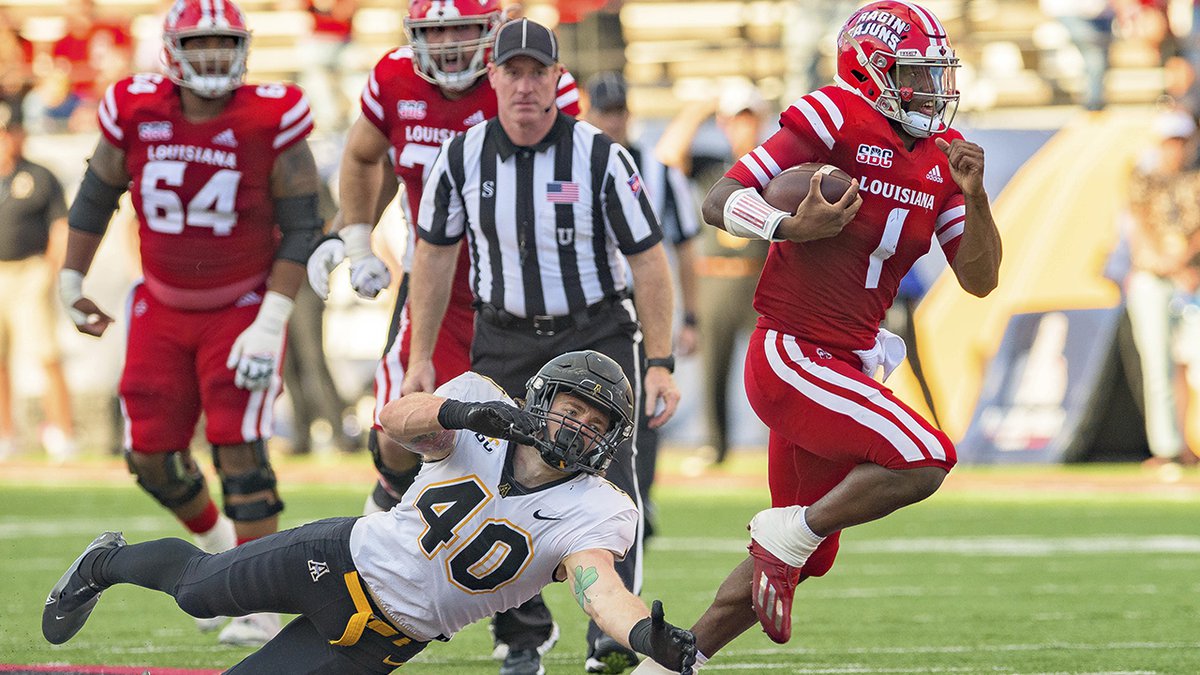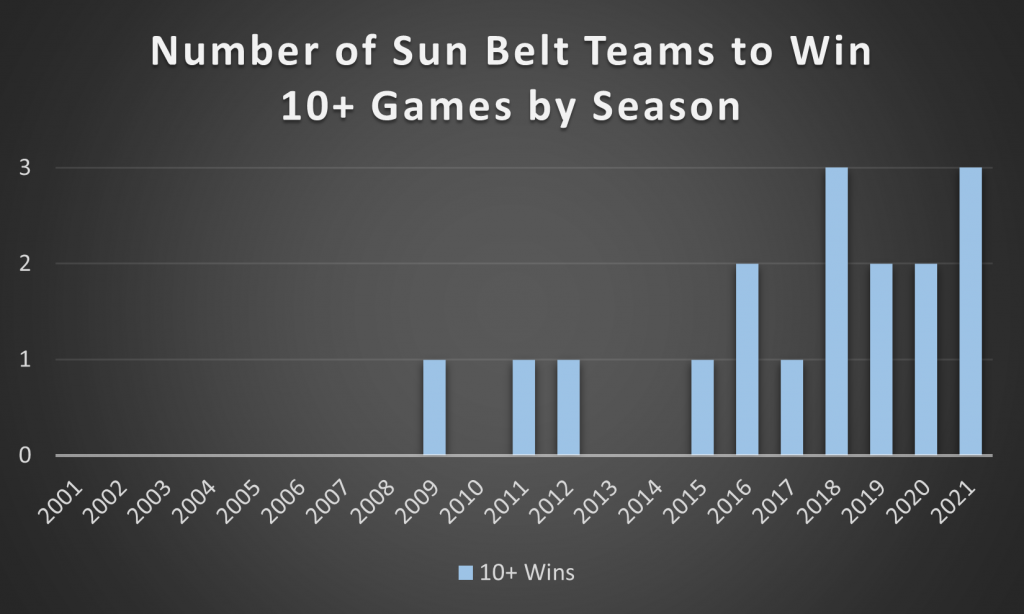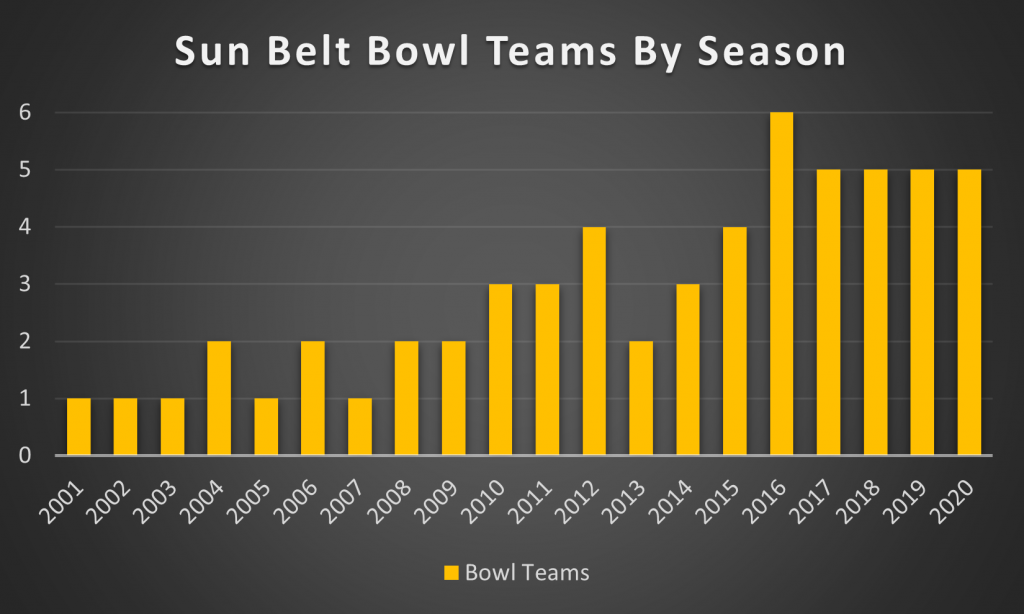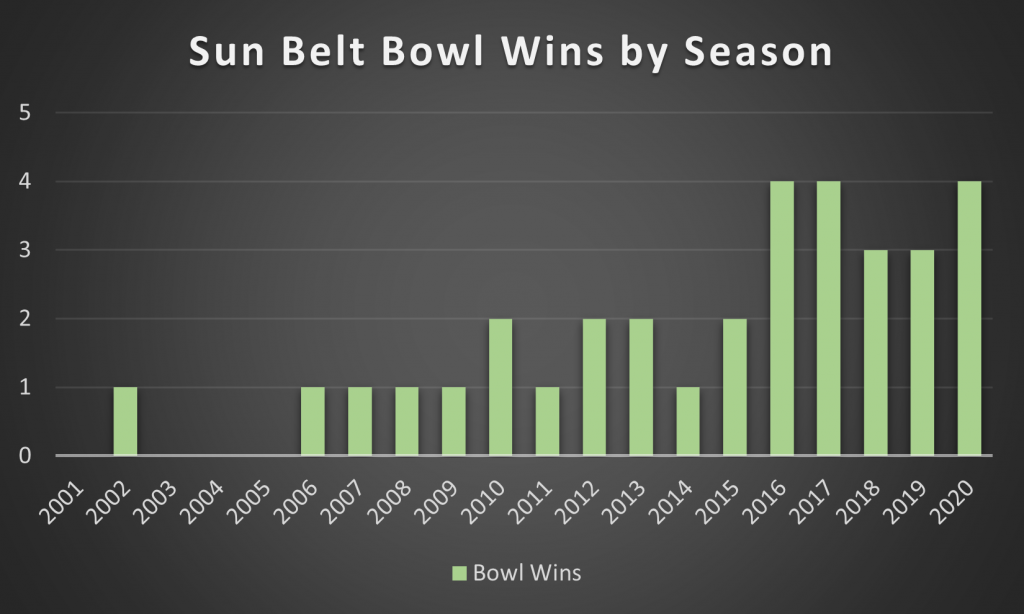Our November 2021 article on winners and losers of the recent college sports realignment opined that the Sun Belt Conference was one of the winners in the latest ongoing realignment cycle. That made us think more about the Sun Belt and look back on the history of the conference. Specifically, we looked at how the football membership has changed since the Sun Belt began sponsoring football in 2001.
The Sun Belt has become one of the emerging Group of 5 conferences in Division 1 college football and is set to strengthen with teams comprised from the mid-Atlantic to the Southeast and Texas as a result of the latest realignment changes. However, it wasn’t always on the ascendancy as there were times it resembled a hodgepodge of schools that simply wanted a place to call home, even if only temporarily.
We’ll take a look at each season since 2001 focusing on the membership changes and overall conference strength. We hope you take the time to read each section to get a better idea of the Sun Belt’s evolution but you can skip to the summary here.
2001 – The Beginning
The Sun Belt Conference began in 1976 as a basketball-only conference but that changed at the turn of the century when they decided to sponsor football. While this could easily be summed up with “and the rest is history”, it’s important to look at the teams that comprised the early seasons to understand how much the Sun Belt has truly evolved.
The first teams were remnants of the Big West and fellow Division 1-A independents (now known as the FBS). Those 7 teams were, well… not great. Only one team – Middle Tennessee – had a winning record in 2000, a feat that was matched in 2001 when they and North Texas were co-champions of the Sun Belt. Also part of the initial group was Idaho, a school that has since returned to the FCS level.
Ultimately, North Texas won the head-to-head matchup against MTSU and went to the New Orleans bowl with a 5-6 record. They were the first team since 1970 to appear in a bowl game with a losing record. They lost 45-20 to Colorado State to finish 5-7 overall. It wasn’t the best start for the new conference but they weren’t dealt the best hand, which makes the ensuing years remarkable.
The table below shows the membership of the football teams for the 2001 Sun Belt season while the map shows the geographic challenges faced by the newest D1 football conference.
| Team | 2000 Conference | 2000 Record | 2001 Record (SBC Record) |
|---|---|---|---|
| Middle Tennessee | 1-A Independent | 6-5 | 8-3 (5-1) |
| North Texas | Big West | 3-8 | 5-7 (5-1) |
| New Mexico State | Big West | 3-8 | 5-7 (4-2) |
| Louisiana-Lafayette | 1-A Independent | 1-10 | 3-8 (2-4) |
| Arkansas State | Big West | 1-10 | 2-9 (2-4) |
| Louisiana-Monroe | 1-A Independent | 1-10 | 2-9 (2-4) |
| Idaho | Big West | 5-6 | 1-10 (1-5) |
2003 – The First of Many Changes
After a 2002 season in which North Texas repeated as conference champions and won the conference’s first bowl game, 2003 saw another team join the fray. Utah State left 1-A independent status to join the Sun Belt and become the 8th football member. The Aggies brought some symmetry to the western geography problem that Idaho and New Mexico State faced as shown in the map below. (Teams that join the conference are shown in yellow on the ensuing maps).
The 2003 season once again saw North Texas win a 3rd straight conference title as the only team to finish with a winning record. The Mean Green went 9-4 with a loss in the New Orleans Bowl to Memphis.
2004 – Another Team Joins the SBC
2004 was a repeat of 2003: a Division 1-A independent joined the Sun Belt and North Texas won the conference championship. Troy made the move to the Sun Belt and became the 9th football member of the conference.
Troy made the imbalance between the western and eastern teams tip further to the east as shown in the map below. Only two teams finished with a winning record – North Texas and Troy – but 2004 was the first time the Sun Belt sent more than 1 team to a bowl game. Both teams lost their respective bowl games (North Texas in the New Orleans Bowl and Troy in the Silicon Valley Classic).
2005 – The Modern Sun Belt Conference is Born
If there is one season that changed the trajectory of the Sun Belt Conference, it was 2005. We will acknowledge the benefit of hindsight but the changes made for 2005 can still be seen in membership changes to this day. We’ll have more on that insight at the end of the article.
The three western teams of Idaho, New Mexico State, and Utah State left for the WAC – another conference that was undergoing massive changes with 6 former WAC teams leaving for C-USA. The Sun Belt welcomed 2 Division 1-AA (now FCS) teams in Florida Atlantic and Florida International. Total membership was down to 8 but a much more geographically friendly 8 as noticed in the map below.
2005 saw North Texas fail to win the conference title for the first time as the Mean Green fell to 2-9 and tied for 7th place in the conference. Arkansas State claimed its first Sun Belt title in a three-way tie with Louisiana-Lafayette and Louisiana-Monroe. Arkansas State was the lone postseason participant for the Sun Belt in 2005 with a 31-19 loss in the New Orleans Bowl.
2006 through 2011 – The Calm Before the Storm: Part 1
The Sun Belt didn’t see any football membership changes during the 2006, 2007, and 2008 seasons. Troy and Middle Tennessee were co-champions in 2006 with Troy winning the head-to-head meeting. Both teams made a bowl game with Troy winning the New Orleans Bowl and Middle Tennessee losing the Motor City Bowl.
2007 saw Troy become co-champions again but with Florida Atlantic this time. FAU won the head-to-head matchup and went on to the New Orleans Bowl, which they lost. Troy went 8-4 during the regular season but didn’t receive a bowl invitation.
Troy finally won the Sun Belt title outright in 2008 though they lost the New Orleans Bowl 30-27 against Southern Miss. Florida Atlantic finished in a tie for 3rd and was invited to a bowl game over 2nd place Louisiana-Lafayette. FAU won the Motor City Bowl 24-21 over Central Michigan.
The Sun Belt welcomed a 9th football member in 2009 when Western Kentucky completed a year as an FBS independent before they joined the SBC. This gave the conference an 8-game conference schedule with Troy winning a share of a 4th straight title and a 2nd consecutive outright title. Western Kentucky went winless during the 2009 campaign to finish 0-12.
The Sun Belt had two teams make bowl appearances with Troy playing in the GMAC Bowl and Middle Tennessee playing in the New Orleans Bowl. Troy lost its game to finish 9-4 while MTSU defeated Southern Miss to finish 10-3, which made the Blue Raiders the first Sun Belt team to record 10 or more wins in a season.
2010 saw no changes in membership and a familiar name atop the standings: Troy claimed a 5th straight share of the Sun Belt title alongside Florida International. FIU won the head-to-head matchup and went to the Little Caesars Pizza Bowl (defeated Toledo) while Troy also went bowling in the New Orleans Bowl (defeated Ohio). For the first time, the Sun Belt sent 3 teams to bowl games with Middle Tennessee playing in the GoDaddy.com Bowl (lost to Miami (OH)).
In 2011, Arkansas State claimed its second title and first outright title with an undefeated conference record. The Red Wolves became the 2nd Sun Belt team to win 10 or more games though they lost the GoDaddy.com Bowl to finish 10-3. The Sun Belt had a 2nd bowl team in FIU though they lost the St. Petersburg Bowl.
2012 through 2014 – Turbulent Times
South Alabama became another FCS team to move up to the FBS and join the Sun Belt in 2012. South Alabama would be the 10th member but additional membership changes were on the horizon. Arkansas State won a 2nd straight title and posted a 10-3 record. They became the first Sun Belt team to win 10 or more games in back-to-back seasons. The Sun Belt sent a then-SBC record of 4 teams to bowl games (2-2 record).
2013 brought a mass departure of 4 teams from the Sun Belt with Florida Atlantic, Florida International, Middle Tennessee, and North Texas all moving to Conference USA. The Sun Belt brought in Georgia State from the FCS and Texas State from the WAC (the conference dissolved until 2021 when it came back as an FCS conference).
Back down to 8 teams, Arkansas State and Louisiana-Lafayette tied for the SBC title. Louisiana won the head-to-head matchup but later vacated the title due to NCAA infractions. Both teams appeared in a bowl game and won their respective matchups.
One year after losing a net of 2 teams, the Sun Belt expanded in 2014 with the addition of 4 teams and one member leaving. Appalachian State and Georgia Southern both moved up from the FCS while former members Idaho and New Mexico State came back to the SBC. Western Kentucky decided to move to C-USA following the quartet from the previous year.
The new 11-team Sun Belt Conference was won by Georgia Southern, who went undefeated in conference play. The Eagles were ineligible for a bowl game thanks to draconian NCAA rules that prevented new FBS schools from participating in the postseason. The Sun Belt sent the trio of Louisiana, Arkansas State, and South Alabama to a bowl game (1-2 record).
2015 through 2017 – Another FCS Addition
The next few years were relatively calm in terms of Sun Belt membership. 2015 was the second season of 11 teams as Arkansas State took the Sun Belt crown again with an undefeated conference record. Both App State and Georgia Southern impressed in year 2 making and winning a bowl game with the Sun Belt sending 4 teams to the postseason (2-2 record).
2016 marked the final season of an 11-team Sun Belt Conference. Appalachian State and Arkansas State were co-champions. The Sun Belt set a conference best with 6 teams invited to bowl games and a 4-2 record. The Sun Belt also had not one but two teams post 10 or more wins on the season for the first time.
In 2017, Coastal Carolina joined the Sun Belt after previously being – you guessed it – an FCS team. This gave the SBC a 12th team, which opened the possibility of adding a conference championship game although the 12-team membership wouldn’t last long. Appalachian State once again tied for the conference title, this time with Troy. Five Sun Belt teams went bowling and they posted a 4-1 record, matching the previous season’s bowl wins total with one less game.
2018 – The Sun Belt Sets on the West… Again
For the second time in the Sun Belt’s short history, the duo of Idaho and New Mexico State departed the conference. Idaho opted to drop down to the FCS level while New Mexico State became an FBS independent. These changes condensed the Sun Belt to the Southern parts of the US for a second time. Along with the reduction to 10 teams, the Sun Belt was split into East and West divisions and instituted a conference championship after the NCAA relaxed the 12-team requirement.
App State won the inaugural SBC Championship game with a 30-19 victory over Louisiana. Three teams posted 10 or more victories in the season for the first time in Sun Belt history (all came from the East Division) with 5 teams going to bowl games (3-2 record).
2019 through 2022 – The Calm Before the Storm: Part 2
The second season featuring 10 teams saw App State win a 2nd straight title in 2019 and did so against Louisiana… again. Both of those teams posted 10+ wins and the conference sent at least 5 teams to bowl games for the fourth straight season (3-2 record).
The COVID ravaged 2020 season did not see a championship game played, which led to Coastal Carolina and Louisiana both being declared champions of the Sun Belt. Once again, two Sun Belt teams won at least 10 games and 5 teams went to a bowl game (4-1 record).
In 2021, the Sun Belt saw Appalachian State and Louisiana meet in the title game for the second time in 3 seasons. This time, it was Louisiana that came away with the Sun Belt title as they defeated App State 24-16. While we are awaiting the bowl results for the 2021 season at the time of posting this article, the Sun Belt will have 3 teams finish with 10 or more wins for the second time in conference history.
2022 and Beyond – Expansion to 14 Football Teams
The future of the Sun Belt Conference is bright. Beginning in 2022, they will have a total of 14 members as James Madison will move up from the FCS, and the trio of Marshall, Old Dominion, and Southern Miss will join from Conference USA. It will be a much different Sun Belt than what it started out as in 2001 but a much stronger and more geographically logical conference than the 2001 version.
Key Takeaways and Summary
Looking back on the Sun Belt’s history, it’s pretty clear they went from a loose collection of mediocre teams to a solid, respectable conference. Let’s give a few stats to illustrate this point.
In the first 15 seasons of the Sun Belt football (2001 through 2015), only 4 teams managed to win 10 or more games during that time. In the last 6 seasons (2016 through 2021), they’ve had 13 teams do so including Appalachian State, Coastal Carolina, and Louisiana in 2021 before conference championships and bowl season even began.
During the same time frame of 2001 through 2015, the Sun Belt went 15-17 in bowl games, which equates to a 47% win rate. From 2016 through 2020, the Sun Belt has gone 18-8 – good enough for a 69% win rate. Even if the Sun Belt goes 0-4 during the 2021 bowl season, they’d still have a win percentage of 60%. Sure, there are more bowl games than ever but the increased win percentage is a good indication of how the Sun Belt has grown in terms of quality on the field.
There’s another aspect that we alluded to many times and it’s that the Sun Belt has plucked a lot of teams from the ranks of the FCS. Excluding the original 7 teams that made up the Sun Belt, there have or will be a total of 17 teams added by the conference through the 2022 season. 11 of those 17 schools will have left the FCS within the prior 5 seasons to become members of the Sun Belt and that includes the return of Idaho and New Mexico State in 2014.
(Full disclosure: If we included the original 7 teams from 2001, the numbers would be 12 of the 24 teams added by the Sun Belt since 2001 would have played in the FCS in the 5 seasons prior to joining the SBC. Excluding the return of Idaho and NMSU, that would be 12 of 22. In either case, at least half of the additions are previous FCS teams, which is a clear pattern).
And it’s not that the Sun Belt is taking just any random teams out of the FCS. They tend to take historically good FCS programs as noted here. When Troy (2001), Western Kentucky (2009), Appalachian State (2014), Georgia Southern (2014), and Coastal Carolina (2017) joined the Sun Belt, all of them had multiple playoff appearances in the 5 years prior to moving to the FBS. The same will be true for James Madison when they join in 2022. All of those programs have shown they can compete at the highest level of FCS football, which makes the move up to FBS easier in theory.
The Sun Belt has also taken new programs as well, which is a bit riskier but the conference has had success doing so. FAU, FIU, Georgia State, and South Alabama all joined the Sun Belt as a “new” program, which means a maximum of 2 or 3 seasons at the FCS level before jumping to the FBS. Only FIU took longer than 4 seasons to reach a bowl game as an FBS program (it took them 7 FBS seasons). On top of all that, most of the current members, future members, and previous FCS call-ups have come from the “sweet spot” of football – the southern US, which, relatedly, is also seeing a massive influx in population.
The Sun Belt had two teams listed in the final College Football Playoff rankings in 2020 and had two preseason top 25 teams in 2021. Neither of those had happened previously. There’s enough evidence that the Sun Belt has made great strides even when accounting for the ever-expanding bowl game schedule.
Simply put, the Sun Belt has been good at picking good programs to join the conference. They’ve built a brand around former FCS teams, which will be even more evident in 2022 when the next four members join. Of the 7 most eastern teams in the Sun Belt in the 2022 membership, 6 of them will have spent time in the FCS during the previous decade. The lone exception will be Marshall, who was great in their own right between 1987 and 1996 before they also made the move to the FBS (Marshall went to 6 1-AA/FCS championship games in that period, winning 2 titles).
Of all the moves made by the Sun Belt since 2005, most have been well-intentioned with one exception: bringing back Idaho and New Mexico State. On one hand, this move made sense to give the conference 12-teams to be able to play a conference championship game. In addition, there was a lot of turnover within the conference membership and these two helped bolster the numbers. However, long term, neither team fit the strategic vision they had cultivated since 2005 which was focused on the southern US and bringing in upcoming football programs. While the Sun Belt rightly cast off the duo following the 2017 season, it was one of the rare missteps in an otherwise impressive evolution.
There might be debates on how the Sun Belt ranks among the Group of 5 conferences in the FBS but there’s no debate on whether the Sun Belt has changed for the better since 2001. The Sun Belt has improved leaps and bounds from its modest beginnings in 2001 in terms of forging an identity and playing better football. It’s hard to imagine that will suddenly stop given the strength they have built over the last decade as the Sun Belt seeks to prove they’re one of the top Group of 5 conferences.
However, if there’s one thing realignment has taught us it’s that fortunes can change quickly for schools and conferences alike. The Sun Belt needs to ensure they don’t fall victim to those circumstances given the growth they’ve experienced over the last 20 years.
Photo courtesy of Matthew Hinton / AP



